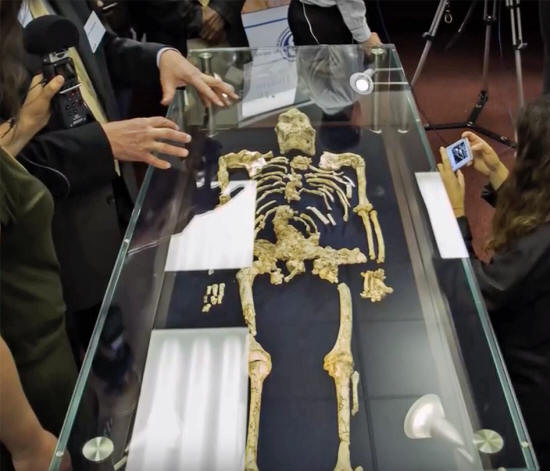|

by Ancient Code Team
December 03,
2019
from
AncientCode Website

Little Foot
via
Wits University, YouTube
A new scientific study suggests scientists may just have come across
a new species of ancient humans.
Meet 'Little
Foot,' an ancient hominin believed to have lived on
Earth around 3.67 MILLION years ago.
Scientists say that this
species is unlike anything we've ever seen before, and maybe a
completely new human species.
The skeleton's analysis resulted in four different scientific papers
(see 'References' far below) which are currently being
peer-reviewed. They claim that the skeleton is of an elderly female
with a crippled left arm does not belong to any known category of
early humans.
The skeleton is odd for a number of reasons.
Scientists
have found that the woman had
legs longer than her arms, a trait commonly associated with the
evolution of modern humans, as it favors bipedalism - the
ability to walk on two legs.
Further studies determined that the woman was on a vegetarian
diet, and stood a little over 1.30 meters, or 4.2 feet tall.
The 'new' species has
been dubbed
Australopithecus prometheus.
The skeletal remains were discovered in the
Sterkfontein caves near
Johannesburg in 1994.
Shortly after, scientists categorized the skeleton as being a member
of the Australopithecus, a group of human ancestors to which the
famous fossil 'Lucy' belongs.
The debate on what species Little Foot belonged to has been
going on for more than two decades.
Dr. Ronald Clarke of the University of the Witwatersrand in
Johannesburg is one of the many scientists who argue that Little
Foot does not fit into the Australopithecus group of
hominins.
Dr. Clarke claims that Little Foot is an entirely new human
species: Australopithecus prometheus.
“I've spent 20 years
getting this skeleton, finding it in the rock in the deep
darkness of the cave, locating every bone, and then cleaning it
sufficiently so we could identify them in the cave, undercutting
them, bringing them out in blocks, cleaning them, reconstructing
them,”
explained Dr. Clarke in an
interview with New Scientist.
See Ron Clarke from the
Evolutionary Studies Institute at Wits University discuss
Little Foot below:
Little Foot, formerly known as StW573 had bones much
smaller compared to larger hominins that are known to have existed
at the same time.
The new studies discovered that the elderly woman had a severe
injury:
Little Foot's left
forearm created 'bilateral asymmetry,' causing her left limb to
become deformed with respect to her height.
It is believed that
Little Foot fell onto an outstretched arm as a child, and the
resulting injury most likely troubled her during her entire life.
More about Little Foot and how they dated the skeleton to 3.67
million-years-old below:
References
| 

